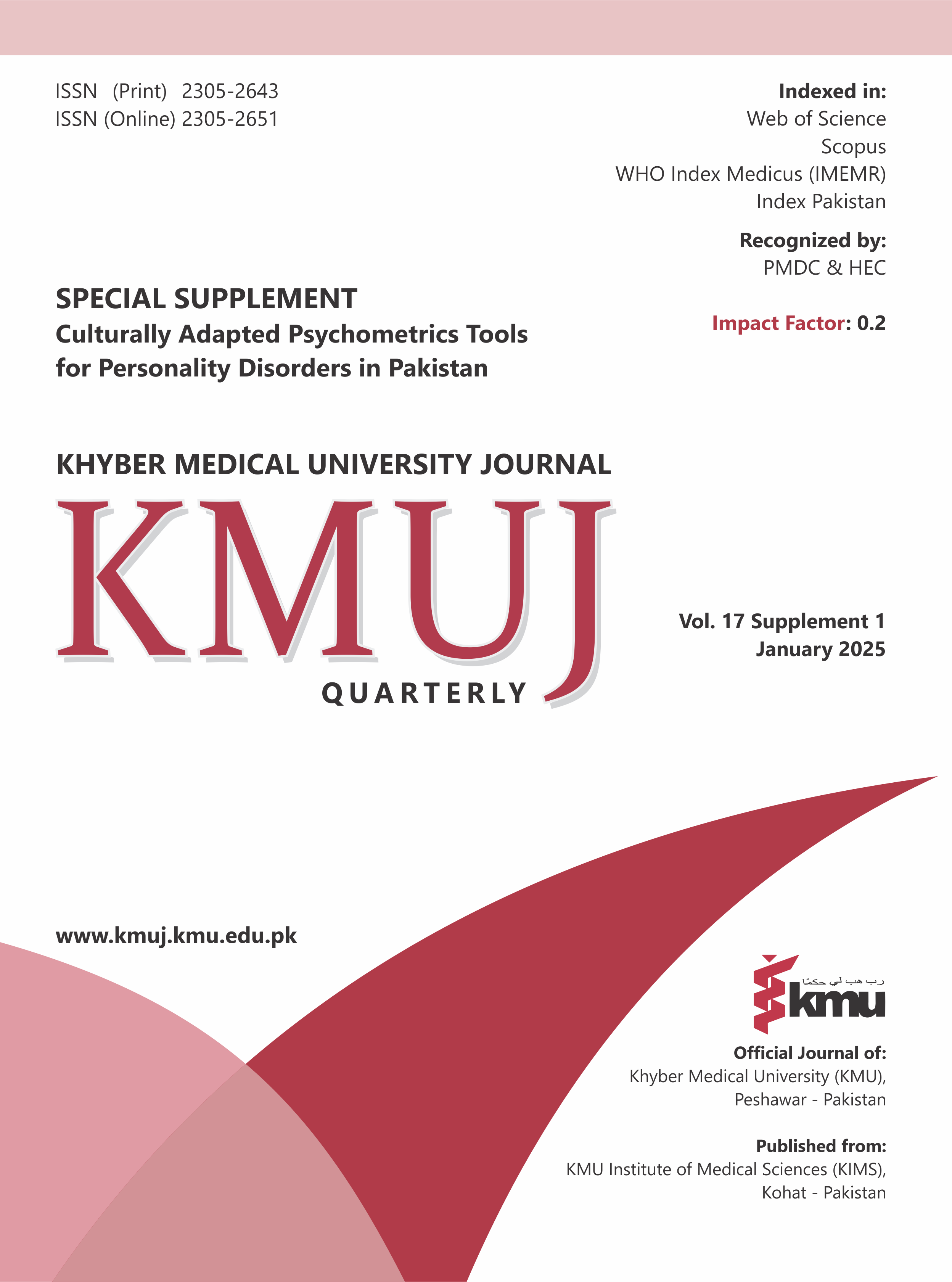Development and psychometric validation of the Urdu-language Avoidant personality disorder scale for adults: a reliable and culturally relevant measure
Main Article Content
Abstract
Objective: To develop and validate an Urdu version of the Avoidant Personality Disorder (AvPD) scale, tailored to the Pakistani population, addressing a gap in culturally relevant psychological assessments.
Methods: A cross-sectional, analytical design was used with data collected from 234 adults (107 males, 127 females) including 100 clinical and 134 non-clinical participants recruited from government and private institutions in Gujrat, Pakistan. The scale development involved generating an initial pool of 104 items, refining it to 91 through expert evaluation, and further reducing it to 62 items after a tryout phase with 104 participants, followed by pilot testing and expert review. Exploratory Factor Analysis (EFA) and Confirmatory Factor Analysis (CFA) were employed to determine the scale’s factor structure. Reliability was assessed using Cronbach's alpha, and convergent validity was tested by correlating the scale with the Social Anxiety Scale for Adolescents (SAS).
Results: The final AvPD scale comprised 37 items across nine subscales and demonstrated strong psychometric properties. EFA revealed the scale explained 68.79% of the variance, while CFA confirmed the factor structure with an excellent model fit (CFI = 0.924, RMSEA = 0.055). The overall reliability of the scale was high (Cronbach's α = 0.964), with subscale reliabilities ranging from 0.764 to 0.931. The scale exhibited moderate convergent validity (r = 0.644) with the SAS.
Conclusion: The Urdu AvPD scale is a reliable, valid tool for assessing AvPD in Pakistan, with potential for clinical and research application. Future studies should explore its applicability across diverse populations to further establish its generalizability.
Article Details

This work is licensed under a Creative Commons Attribution 4.0 International License.
Work published in KMUJ is licensed under a
Creative Commons Attribution 4.0 License
Authors are permitted and encouraged to post their work online (e.g., in institutional repositories or on their website) prior to and during the submission process, as it can lead to productive exchanges, as well as earlier and greater citation of published work.
(e.g., in institutional repositories or on their website) prior to and during the submission process, as it can lead to productive exchanges, as well as earlier and greater citation of published work.
References
1. American Psychiatric Association. Diagnostic Statistical Manual for Mental Disorders. 5th ed. Arlington, V.A: American Psychiatric Publications 2013;669-71.
2. Nedic A, Zivanovic O, Lisulov R. Nosological status of social phobia: contrasting classical and recent literature. Curr Opin Psychiatry 2011;24(1):61-6. https://doi.org/10.1097/yco.0b013e32833fb5a6
3. Huppert JD, Strunk DR, Ledley DR, Davidson JRT, Foa EB. Generalized social anxiety disorder and avoidant personality disorder: structural analysis and treatment outcome. Depression Anxiety 2008;25(5):441-8. https://doi.org/10.1002/da.20349
4. Herbert JD, Hope DA, Bellack AS. Validity of the distinction between generalized social phobia and avoidant personality disorder. J Abnorm Psychol 1992;101(2):332-9. https://doi.org/10.1037//0021-843x.101.2.332
5. Lampe L, Sunderland M. Social phobia and avoidant personality disorder: similar but different? J Pers Disord 2015;29(1):115-30. https://doi.org/10.1521/pedi_2013_27_079
6. Trull TJ, Jahng S, Tomko RL, Wood PK, Sher KJ. Revised NESARC personality disorder diagnoses: gender, prevalence, and comorbidity with substance dependence disorders. J Pers Disord 2010;24(4):412-26. https://doi.org/10.1521/pedi.2010.24.4.412
7. Quirk SE, Berk M, Pasco JA, Brennan-Olsen SL, Chanen AM, Koivumaa-Honkanen H, et al. The prevalence, age distribution and comorbidity of personality disorders in Australian women. Aust N Z J Psychiatry 2017;51(2):141-50. https://doi.org/10.1177/0004867416649032
8. Zimmerman M, Rothschild L, Chelminski I. The prevalence of DSM-IV personality disorders in psychiatric outpatients. Am J Psychiatry 2005;162(10):1911-8. https://doi.org/10.1176/appi.ajp.162.10.1911
9. Lampe L, Malhi GS. Avoidant personality disorder: current insights. Psychol Res Behav Manag 2018;11:55-66. https://doi.org/10.2147/prbm.s121073
10. Mushquash CJ, Bova DL. Cross-cultural assessment and measurement issues. J Dev Disabil 2007;13(1):53-66.
11. Tay L, Jebb A. Scale Development. In: Rogelberg SG (editor), The SAGE Encyclopaedia of Industrial and Organizational Psychology. 2nd ed. 2017. SAGE Publications, New Delhi, India. https://doi.org/10.4135/9781483386874
12. Likert R. A technique for the measurement of attitudes. Arch Psychol 1932;22(140):5-55.
13. Rahn M. Factor Analysis: A Short Introduction, Part 5–Dropping unimportant variables from your analysis 2018. [Accsessed on: July 22, 2019]. Available from URL: https://www.theanalysisfactor.com/fa ctor-analysis-5/
14. Miller-Carpenter S. Ten steps in scale development and reporting: a guide for researchers. Commun Methods Meas 2018;12(1):25-44. http://dx.doi.org/10.1080/19312458.2017.1396583
15. Griethuijsen RALF, Eijck MW, Haste H, Brok PJ, Skinner NC, Mansour N, et al. Global patterns in students’ views of science and interest in science. Res Sci Educ 2014;45(4):581-603.
16. Ahmad R, Bano Z. Translation and psychometric of social anxiety scale for adolescents for assessment in Pakistan. Pak J Psychol Res 2013;44(1):67-80.
17. Sanislow CA, da Cruz K, Gianoli MO, Reagan ER. Avoidant Personality Disorder, Traits, and Type. In: Widiger TA (ed), The Oxford Handbook of Personality Disorders. Oxford University Press, New York, USA. 2012. pp:549-65. ISBN: 9780199735013. https://doi.org/10.1093/oxfordhb/9780199735013.013.0025
18. Lynam DR, Loehr A, Miller JD, Widiger TA. A five-factor measure of avoidant personality: the FFAvA. J Pers Assess 2012;94(5):466 -74. https://doi.org/10.1080/00223891.2012.677886
19. Hays PA. Addressing cultural complexities in practice. A framework for clinicians and counsellors. American Psychological Association, Washington, DC. 2001. https://awspntest.apa.org/doi/10.1037/10411-000
